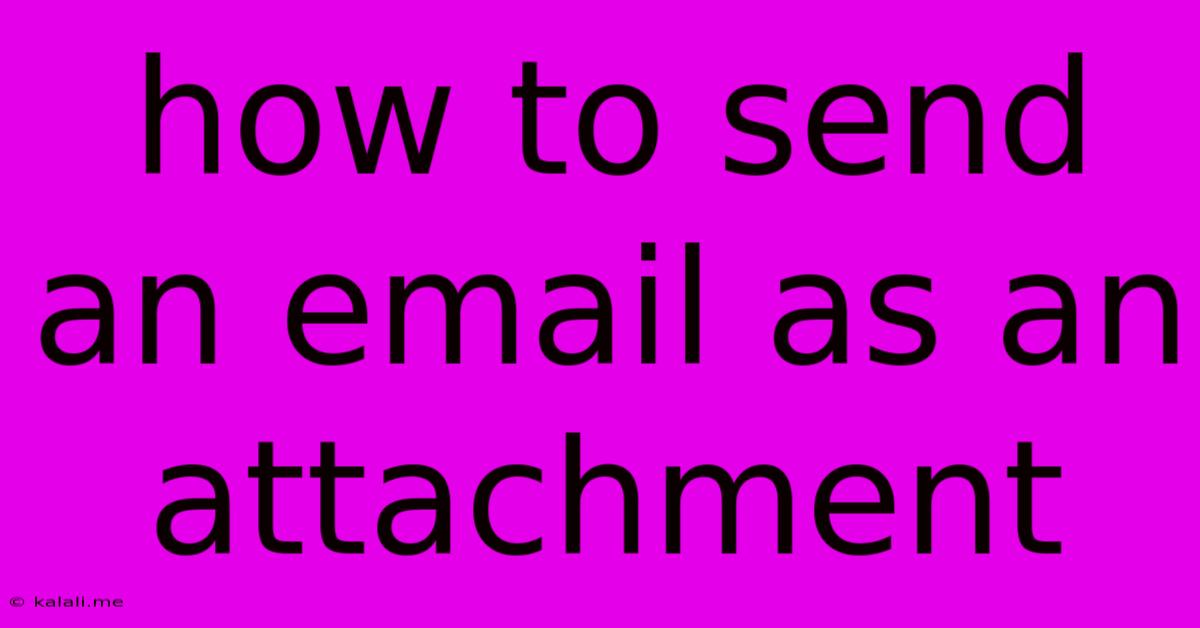How To Send An Email As An Attachment
Kalali
Jun 09, 2025 · 3 min read

Table of Contents
How to Send an Email as an Attachment: A Comprehensive Guide
Sending an email as an attachment might sound unusual, but it's a perfectly valid task, especially when you need to preserve the original email's formatting or send it to someone who doesn't have access to your email client. This guide will show you how to achieve this, covering various email platforms and methods. This technique is particularly useful for archiving important correspondence, sharing email evidence, or securely transferring email conversations.
This article will cover various methods to achieve this, ensuring your email reaches the recipient safely and maintains its original format. We'll discuss saving the email as various file types, and the pros and cons of each approach.
Understanding the Process: Why Send an Email as an Attachment?
Before diving into the technical steps, let's understand why you might want to send an email as an attachment. Several scenarios make this approach necessary:
- Preserving Formatting: Email clients render HTML and plain text differently. Sending an email as an attachment guarantees the recipient sees the exact formatting you intended, including images, fonts, and layout.
- Sharing with Non-Email Users: Some individuals might not have an email account. Sending the email as a file allows you to share the content with them through other channels, like file-sharing platforms.
- Legal or Evidentiary Purposes: When you need to maintain an exact record of an email exchange, sending it as an attachment provides a tamper-evident copy.
- Archiving Emails: Storing emails as attachments in a structured folder system can simplify your archiving and retrieval processes.
Methods for Sending an Email as an Attachment
The method for sending an email as an attachment varies slightly depending on your email client. However, the general steps remain consistent across platforms:
1. Saving the Email as a File:
This is the crucial first step. Most email clients allow you to save emails in various formats:
- .MSG (Outlook): This format preserves the most email data, including formatting, attachments, and other metadata. It's best for Outlook users or when maximum fidelity is required.
- .EML: This is a more universal format, compatible with many email clients. It retains much of the original formatting.
- PDF: Converting to PDF offers a widely compatible and printable option. However, it might lose some dynamic email elements.
- HTML: This preserves the underlying HTML structure of the email. This can be useful if you need to work with the email's content in a web editor.
The exact method for saving the email varies based on your client:
- Outlook: Right-click on the email and select "Save As."
- Gmail: There isn't a direct "Save As" option in Gmail's web interface. You can usually print to PDF, or use browser extensions for better options.
- Other Clients: Most other clients offer similar "Save As" or "Export" functionalities within the email's context menu.
2. Attaching the Saved File to a New Email:
Once you've saved the email as a file, you can attach it to a new email message using standard attachment procedures.
- Compose a new email.
- Locate the saved email file.
- Click the "Attach file" button.
- Select the file.
- Send the email.
Choosing the Right Format: .MSG vs. .EML vs. PDF
The choice of file format depends on your needs:
- .MSG: Best for preserving all email details, ideal for internal use within an Outlook environment.
- .EML: A widely compatible alternative, suitable for sharing across different email platforms.
- PDF: Excellent for archival purposes and readability on any device; however, it might not perfectly preserve dynamic email elements.
Troubleshooting Common Issues
- File Size: Very large emails might exceed attachment size limits. Consider compressing the file or using a file-sharing service for larger emails.
- Compatibility Issues: Ensure the recipient's email client can open the chosen file format. PDF is generally the safest bet for broad compatibility.
By following these steps, you can confidently send emails as attachments, ensuring your message reaches its destination while preserving its intended format and content. Remember to consider your recipient's email client and choose the appropriate file format for optimal compatibility.
Latest Posts
Latest Posts
-
What Is A Two Way Mirror
Jun 09, 2025
-
How Long To Jump A Dead Battery
Jun 09, 2025
-
This Produces All Possible Combinations Of Factors
Jun 09, 2025
-
How Long Should A Refrigerator Water Filter Last
Jun 09, 2025
-
How To Remove Valid For Work Only With Dhs Authorization
Jun 09, 2025
Related Post
Thank you for visiting our website which covers about How To Send An Email As An Attachment . We hope the information provided has been useful to you. Feel free to contact us if you have any questions or need further assistance. See you next time and don't miss to bookmark.